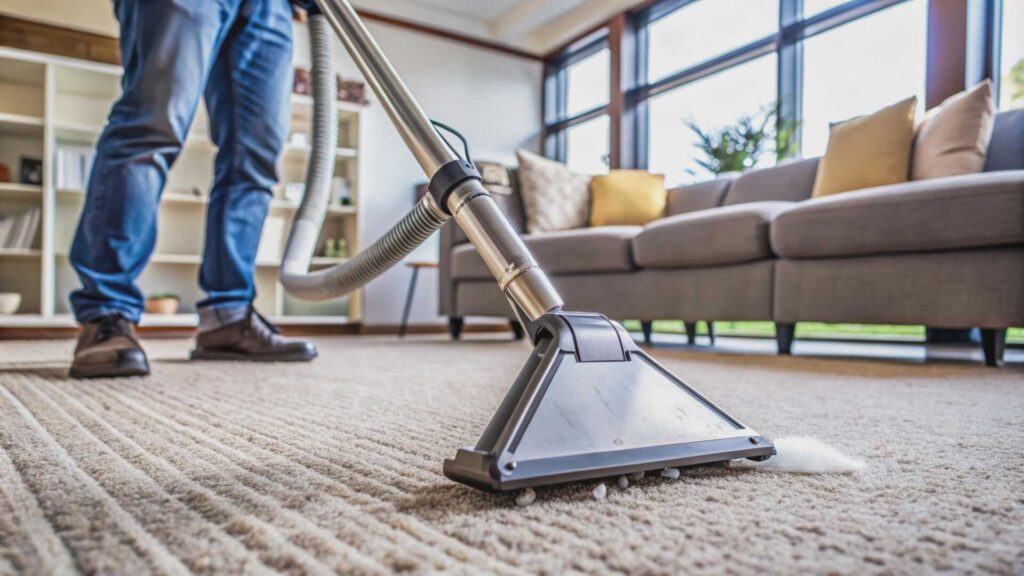
Contents
When facing a sudden water emergency, every moment counts. Imagine the panic of a burst pipe or a flooded basement—what would you do first? The key is swift action to mitigate the damage. But how do you navigate the chaos and guarantee a quick resolution? Let’s explore some essential tips to help you handle water extraction efficiently and find the support you need in these critical moments.
Key Takeaways
- Contact emergency services promptly for professional water extraction assistance.
- Utilize industrial pumps and wet/dry vacuums for quick water removal.
- Turn off electrical sources in the affected area to ensure safety during extraction.
- Use fans and dehumidifiers to expedite the drying process.
- Wear protective gear like gloves and rubber boots for personal safety.
Understanding Water Damage
Water damage can be a devastating occurrence in any home or property. When faced with water damage, the first step is to conduct a thorough damage evaluation to understand the extent of the problem. This involves inspecting the affected areas, determining the category of water damage (clean, gray, or black water), and evaluating the level of destruction to the property.
Once the damage evaluation is complete, the next important step is to initiate the restoration process. This process involves removing excess water using specialized equipment such as pumps and vacuums to prevent further damage to the property.
It’s crucial to dry out the affected areas completely to prevent mold growth and structural issues.
After water extraction, the restoration process continues with cleaning and sanitizing the space. This step is essential to guarantee the safety and health of those residing on the property. Additionally, any salvageable items should be carefully cleaned and restored to their pre-damaged condition.
Throughout the restoration process, it’s vital to work with professionals who have the expertise and equipment to handle water damage effectively. They can provide guidance on the best course of action and ensure that the restoration process is carried out efficiently.
Identifying the Source
When dealing with water damage, the first step is identifying the source. Locate where the water is coming from to prevent further damage. Understanding the type of water involved is essential for effective cleanup and restoration.
Source Location
To effectively address water extraction, one vital step is identifying the source of the water. Hidden leaks and plumbing issues are common culprits behind water damage. Start by investigating areas where water is pooling or dripping. Check under sinks, around toilets, near water heaters, and in basements or crawl spaces. Look for any signs of water stains, mold growth, or musty odors, as these can indicate the presence of hidden leaks.
If you suspect a plumbing issue, turn off the water supply to your home immediately to prevent further damage. Inspect your plumbing fixtures for any visible leaks or signs of corrosion.
Don’t forget to examine the ceilings and walls for any discoloration or bubbling paint, which could point to a hidden leak within the walls or roof.
Identifying the source of the water is essential in determining the appropriate extraction methods and preventing future water damage. If you’re unable to locate the source or if the damage is extensive, it’s best to contact a professional water extraction service for assistance.
Water Type
One way to further address water extraction effectively is by understanding the type of water you’re dealing with. Water classification is pivotal in determining the appropriate cleanup procedures. There are three main categories of water that can impact your property: clean water, gray water, and black water.
Clean water is the least contaminated type of water, often originating from sources like broken pipes or overflowing sinks. Cleanup procedures for clean water involve extracting the water and drying the affected area thoroughly to prevent mold growth.
Gray water is slightly contaminated and may result from sources such as washing machines or dishwashers. When dealing with gray water, it’s essential to wear protective gear and ensure adequate ventilation during cleanup to avoid health risks.
Black water is the most hazardous type of water, containing harmful bacteria and pathogens. It can come from sewage backups or natural disasters. Due to the high health risks involved, cleanup procedures for black water require professional assistance. Remember to prioritize safety and seek professional help when dealing with gray or black water to guarantee a thorough and safe cleanup process.
Calling Emergency Services
In the event of a water-related emergency, promptly contacting local emergency services is essential. When reaching out to emergency services, it’s important to provide them with as many details as possible about the situation. Let them know the extent of the water damage, the source of the water, and if there are any safety concerns.
Emergency services are equipped with the proper tools and knowledge to handle water-related emergencies. They’ve the expertise to assess the situation, determine the best course of action, and mitigate further damage. By contacting them immediately, you make sure that the proper equipment and personnel are dispatched to your location promptly.
Remember, time is critical when dealing with water damage. Immediate action can help prevent the situation from worsening and minimize the impact on your property.
Emergency services understand the urgency of water-related incidents and will respond promptly to assist you in addressing the issue.
Preparing the Area
When facing a water-related emergency, ensuring the area is properly prepared can greatly aid in the mitigation process. Start by focusing on drying techniques.
- Open windows and doors to increase ventilation and aid in the evaporation process.
- Use fans to circulate air and dehumidifiers to reduce moisture levels in the air.
- If safe to do so, consider using towels or mops to remove excess water, but be cautious of electrical hazards.
Next, prioritize furniture protection.
- Move furniture to a dry area, if possible, to prevent further damage.
- Place aluminum foil or wood blocks under furniture legs to elevate them and avoid contact with water.
- Lift any curtains or draperies off the floor to prevent wicking.
- Remove any valuable or sentimental items from water-exposed areas.
Additionally, be mindful of safety precautions.
- Avoid using electrical appliances in wet areas to prevent the risk of electric shock.
- Wear protective gear like rubber gloves and boots when handling water-damaged items.
- If the water damage is extensive or contaminated, it’s best to seek professional help for thorough cleaning and restoration.
Extraction Process Overview
To effectively address water extraction, understanding the process overview is crucial. When it comes to water extraction, having the right equipment is vital. You’ll need tools such as industrial pumps, wet/dry vacuums, dehumidifiers, and fans. These tools work together to remove water, dry out the affected area, and prevent mold growth.
The timeframe for water extraction can vary depending on the extent of the damage. In general, the extraction process can take anywhere from a few hours to a couple of days. It’s important to act promptly to minimize the damage and prevent further issues like structural damage or mold growth. The sooner you begin the extraction process, the better the outcome is likely to be.
During the extraction process, it’s essential to prioritize safety. Make sure to turn off any electrical sources in the affected area to prevent accidents. Additionally, wear protective gear such as gloves and rubber boots to avoid any contact with contaminated water.
Follow-Up and Prevention
Implementing prevention strategies and follow-up maintenance after water extraction is crucial for maintaining a dry and safe environment in your home.
By taking proactive measures such as fixing leaks and improving drainage, you can prevent future water damage incidents.
Additionally, scheduling regular inspections and maintenance checks can help guarantee that your property remains safeguarded against potential water issues.
Prevention Strategies
Implementing effective prevention strategies is essential in mitigating the risk of water damage. Two key prevention strategies are moisture control and leak detection. Moisture control involves keeping humidity levels stable and using dehumidifiers in damp areas. Leak detection focuses on regularly inspecting plumbing, appliances, and roofs for any signs of leaks.
To help you better understand these prevention strategies, here is a table outlining some practical tips:
| Prevention Strategy | Tips |
|---|---|
| Moisture Control | – Use exhaust fans in bathrooms and kitchens to reduce humidity levels. |
| – Repair any leaks in roofs or plumbing promptly. | |
| Leak Detection | – Check for water stains on ceilings and walls regularly. |
| – Inspect appliances like washing machines and dishwashers for leaks. |
Follow-Up Maintenance
Regular follow-up maintenance is vital for guaranteeing the effectiveness of your prevention strategies and safeguarding your property against water damage. After water extraction, continue to monitor the affected areas for any signs of moisture or water accumulation. Utilize proper drying techniques, such as dehumidifiers and fans, to make sure all surfaces are thoroughly dry to prevent mold growth.
Inspect the area regularly to check for mold formation. Mold prevention is essential in maintaining a healthy indoor environment. Look for musty odors, discoloration on walls or ceilings, or visible mold growth. If mold is detected, address it promptly with appropriate cleaning solutions and techniques.
Additionally, consider implementing waterproofing measures in areas prone to water damage, such as basements or crawl spaces. Sealing cracks and ensuring proper drainage can help prevent future water intrusion.
Review
Congratulations on completing the quick water extraction process! You’ve successfully prevented further damage and mold growth. Now, sit back and relax as you enjoy the irony of a flood of relief washing over you after dealing with a flood of water. Remember, quick action and expert help are the keys to success in water emergencies. Keep up the good work, and stay prepared for any future water-related challenges!
Recent Posts
What Are Eco-Friendly Water Damage Repair Methods?
When it comes to addressing water damage in an environmentally friendly manner, eco-conscious methods are
7 Best Eco-Friendly Water Damage Repair Methods
When faced with water damage, you must consider the environmental impact of your repair methods.
Sustainable Water Damage Repair Techniques: A How-To Guide
When faced with water damage in your home, it’s crucial to explore sustainable repair techniques
